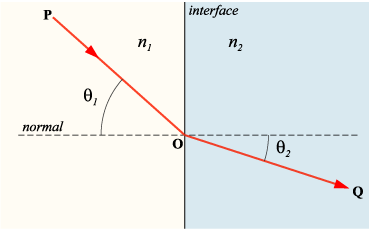
PUMPA - SMART LEARNING
எங்கள் ஆசிரியர்களுடன் 1-ஆன்-1 ஆலோசனை நேரத்தைப் பெறுங்கள். டாப்பர் ஆவதற்கு நாங்கள் பயிற்சி அளிப்போம்
Book Free DemoIn this section, we will discuss the laws related to the refraction of light.
When a light ray travels obliquely from one transparent medium to another, it deviates from its original path.
Refraction is the term for the deviation of a light ray. The variation in the velocity of light in different media causes refraction.
In a low denser medium, light travels faster, while in a denser medium, it travels slower.
Two refraction laws govern the refraction of light.
The first law of refraction:
This law states that the ratio of the sine of the angle of incidence and sine of the angle of refraction is equal to the reciprocal of the ratio of refractive indices of the two transparent media. This law is also known as Snell’s law.
